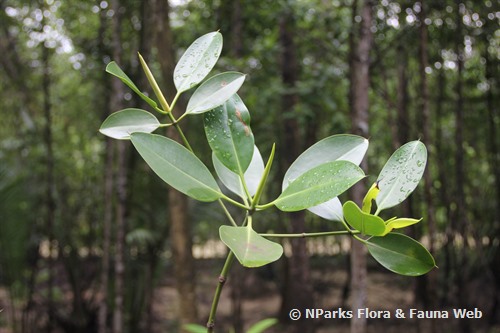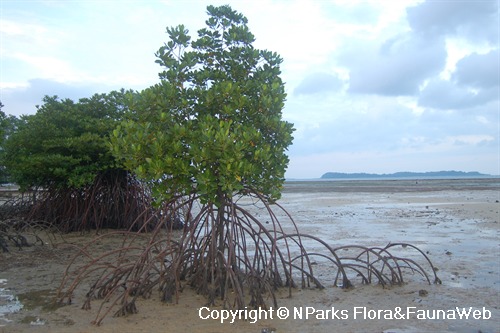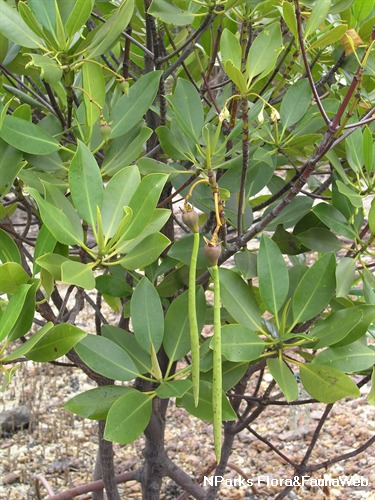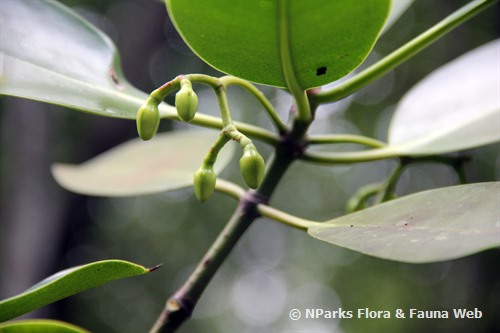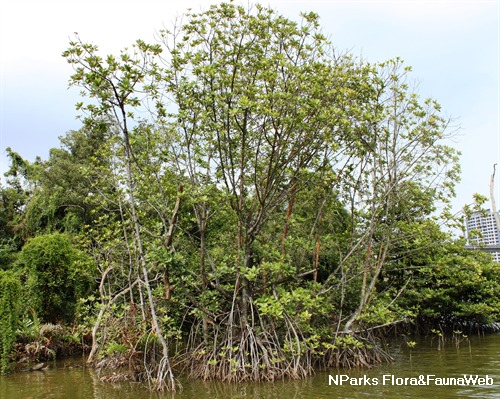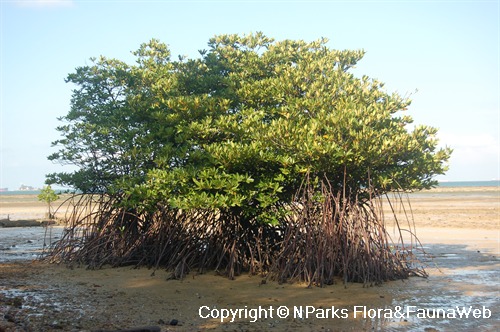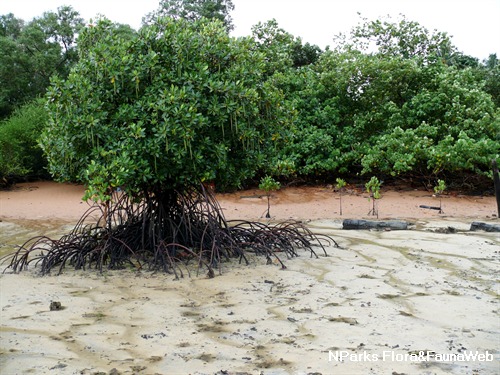
Name
Classifications and Characteristics
| Plant Division | Angiosperms (Flowering Seed Plants) |
|---|---|
| Plant Growth Form | Tree (Medium (16m-30m), Small (6m-15m)) |
| Lifespan (in Singapore) | Perennial |
| Mode of Nutrition | Autotrophic |
| Maximum Height | 20 m |
Biogeography
| Native Distribution | Taiwan, Southeast Asia, including Singapore, Australia and Papua New Guinea |
|---|---|
| Native Habitat | Shoreline |
| Preferred Climate Zone | Tropical, Sub-Tropical / Monsoonal |
| Local Conservation Status | Native to Singapore (Vulnerable (VU)) |
Description and Ethnobotany
| Growth Form | Small to medium-sized erect tree, can grow up or over to 10 m. |
|---|---|
| Crown | Conical crown |
| Trunk | Smooth, grey to black fissured bark, trunk diameter can reach up to 10 - 15 cm. |
| Roots | Stilt roots measuring up to 3 m long and sometimes aerial roots emerging from the lower branches. |
| Foliage | Leathery leaves, broadly elliptic, measuring 6.5 - 12.5 by 3 - 7.5 cm, has tiny black dots on the lower surface and a pointed tip. Leaf stalk is 1 - 3.5 cm long and with 4 - 6 cm long leaflets at its base. |
| Flowers | Flowers are composed of cream-coloured, linear petals arranged in a cross-shaped pattern. Flower heads are located in the axils and forked 3 - 5 times, with 5 - 8 bisexual flowers, each on a 2.5 - 5 cm long stalk. Flower buds are widest near the base. Four pale-yellow calyx lobes remain present on the fruit and are recurved. The four yellowish to whitish petals are 8 mm long and have densely woolly margins. Each flower has 8 stamens and a 4 - 6 mm long style. |
| Fruit | Brown, pear-shaped fruit hang with the smaller end pointed down. A long, cylindrical propagule emerges from the smaller end, while the fruit is still attached to the parent plant. This condition is known as viviparity. Propagule measures 20 - 35 cm long. |
| Habitat | Found in tidal habitats on mud, sands, coarse grits and rock, preferring banks of tidal rivers, and can also be a pioneering species in coastal environments or on landward margins of mangroves. |
| Cultivation | The seedling, known as a propagule, is planted by placing it vertically in soil. |
| Ethnobotanical Uses | Timber & Products: Wood is used for firewood and charcoal. Others: This species' extensive set of prop roots help to disperse the destructive energy carried by strong tidal waves, helping to protect the shoreline and surrounding areas. |
Landscaping Features
| Landscape Uses | Coastal, Riverine |
|---|
Fauna, Pollination and Dispersal
| Seed or Spore Dispersal | Abiotic |
|---|
Plant Care and Propagation
| Light Preference | Full Sun |
|---|---|
| Water Preference | Lots of Water |
| Plant Growth Rate | Moderate to Slow |
| Rootzone Tolerance | Waterlogged Soils, Saline Soils / Salt Spray |
| Propagation Method | Viviparious Propagule |
Foliar
| Foliage Retention | Evergreen |
|---|---|
| Mature Foliage Colour(s) | Green - Light Green |
| Foliar Type | Simple / Unifoliate |
| Foliar Attachment to Stem | Petiolate |
| Foliar Venation | Pinnate / Net |
Floral (Angiosperm)
| Flower & Plant Sexuality | Bisexual Flowers |
| Flower Colour(s) | Cream / Off-White |
|---|
Fruit, Seed and Spore
| Mature Fruit Colour(s) | Brown |
|---|
Image Repository
Others
| Master ID | 30838 |
|---|---|
| Species ID | 5200 |
| Flora Disclaimer | The information in this website has been compiled from reliable sources, such as reference works on medicinal plants. It is not a substitute for medical advice or treatment and NParks does not purport to provide any medical advice. Readers should always consult his/her physician before using or consuming a plant for medicinal purposes. |

